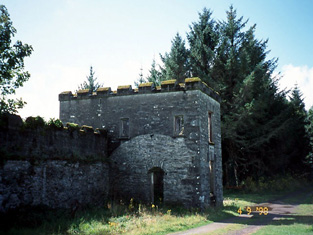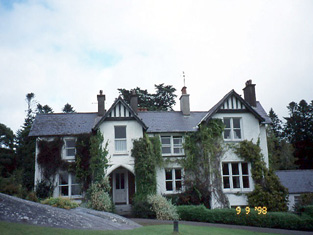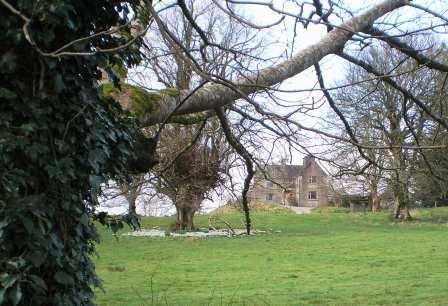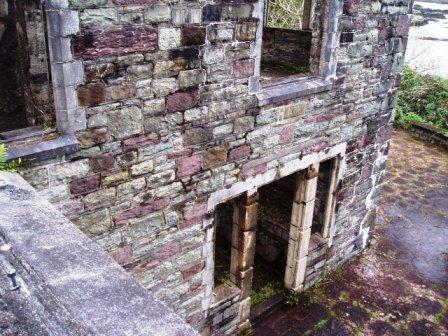Dromore Castle
Houses within 15km of this house
Displaying 26 houses.
Houses within 15km of Dromore Castle
Displaying 26 houses.
| House name | Description | |
|---|---|---|
| Looscaunagh | Henry Herbert was leasing a property valued at almost £4, along with over 400 acres, to Daniel McCarthy at the time of Griffith’s Valuation. It is no longer extant. | |
| Derryquin Castle | At the time of Griffith’s Valuation James F. Bland was leasing a property valued at £29 at Derryquin, from the Guinness estate. Lewis, in 1837, and Leet, in 1814, record the house as the seat of Francis C. Bland . The property was eventually sold by the Blands to the Warden family. In 1906 it was owned by Col. Charles W. Warden and valued at £70. The Wardens resided there until it was burnt in 1922. It was located in the grounds of what is now the Parknasilla Hotel but the ruins were demolished in 1969. See www.parknasillahotel.ie for e-book on the history of this property. |

|
| Hollywood | Frederick Hyde was leasing a house valued at almost £10 from the Bland estate at the time of Griffith’s Valuation. Lewis records Hollywood as the seat of the Hyde family in 1837. Frederick Hyde was married to Elizabeth Bland. Bary states that the house was built in the 1830s, possibly on the site of an older house. It was occupied by the Bland family after they sold Derryquin but later fell into disrepair and is now a ruin. | |
| Parknasilla | James F. Bland was leasing a house valued at £10 to Christopher Bland at the time of Griffith’s Valuation. Bary states that some historians believe this to be the original Bland house in the area. In the mid 19th century it became known as the Bishop’s House as it was leased by the Bland estate to Bishop Graves of Limerick. Later still it became the forerunner of the Parknasilla hotel, in which grounds it is still located. A second house in the townland is labelled Clashnacree House [V721649] on the 25-inch Ordnance Survey map of the 1890s. In 1894 Slater records this latter house as the seat of J.F. Fuller. It is still extant. | |
| Drimna House | James F. Bland was leasing a house valued at £7 to Rev. Arthur Watson at the time of Griffith’s Valuation. In 1906 Col. Charles W. Warden owned a property at Drimnamore, valued at £3 10s. It is still extant. | |
| Parkgariffe | The representatives of Reverend D. Mahony were leasing a house valued at £9 to Barbara Strange at the time of Griffith’s Valuation. This property was included in the sale of the Freeman estate in 1850, when it was occupied by Mrs. Elizabeth Strange, under a lease dating from 1828. Bary states that it was later lived in by the Spottiswood Green family. There is still an occupied house at the site but it may have been altered. | |
| Coomlumminy Court | The representatives of Reverend D. Mahony were occupying a house valued at almost £5, together with over 1400 acres at the time of Griffith’s Valuation. In 1906 this was the property of Mary Mahony and valued at £3. The building was labelled Coomlumminy Court on the 1st and subsequent edition Ordnance Suvey maps and is now a ruin. | |
| Old Dromore House | The representatives of Rev. D. Mahony were leasing a house valued at £25 to James McClure at the time of Griffith’s Valuation. The McClures were the agents for the Mahony estate for many years. It is labelled "Dromore Old" on the 1st edition Ordnance Survey map and as "Old Dromore House" on the later 25-inch edition of the 1890s. Bary states that it was the original Mahony house before the building of Dromore Castle. It is not extant now. | |
| Dunkerron House | Lewis records that Dr. Taylor was occupying a property adjacent to the ruined castle at Dunkerron in 1837. In 1814, Leet refers to Dunkerrin Castle as the seat of George Cashell. At the time of Griffith’s Valuation, Joseph Taylor was leasing a property there valued at £16 15s from Deane Freeman. Bary states that Joseph Taylor was an agent for the Landsdowne estate. The Taylor property then passed to Dr. Thomas Taylor who built Dunkerron House. In 1906 this was the property of Sir John C. Columb and valued at £22. The property is still extant but extensive housing development has taken place in the demesne. | |
| Tubbrid House | At the time of Griffith's Valuation, John M. Hickson was occupying Tubbrid House, parish of Templenoe, valued at £9. Bary states that the house was built by the [O]'Mahony-Hickson family. There is still an occupied house at the site though it may have been altered. . | |
| Derreen | Peter McSweeney was leasing the property at Derreen from the Lansdowne estate at the time of Griffith's Valuation, when it was valued at £6 10s. Lewis also notes it as his residence in 1837. Bary states that Derreen was originally built by a branch of the O'Sullivans from whom it passed to Peter McSweeney who was married to a member of that family. It formed part of the Lansdowne estate and later came into the possession of the Petty-Fitzmaurices. In 1906 it was owned by that estate and was valued at £53 15. It was burnt in the early 1920s but rebuilt in the same style and is still extant and occupied. It is famous for its beautiful gardens. |

|
| Dromneavane | Rev. John O'Sullivan was leasing a property valued at £8 5s from the Lansdowne estate at the time of Griffith's Valuation. Labelled Dromneavane on both the 1st-edition and 25-inch Ordnance Survey Maps. A house still exists at the site. | |
| Lansdowne Lodge | William S. Trench, Lord Lansdowne's agent, was occupying this property at the time of Griffith's Valuation, when it was valued at £27. In 1837 Lewis refers to it as the residence of the then agent, J. Hickson. Bary states that it was the home of the various agents of the Lansdowne estate throughout the nineteenth and early twentieth centuries. It was demolished in the latter decades of the twentieth century and a housing estate built on the grounds. | |
| Reenmore House | Rev. John Day was leasing a property valued at £12 15s from the Lansdowne estate at the time of Griffith's Valuation. This may have been the conjoined property labelled Sound House and Fir View on the 1st edition Ordnance Survey Map. On the 25-inch map of the 1890s, Sound House has become known as Reenmore House. The are still extant buildings at the site. | |
| Sheen Cottage/The Falls | George Woodhouse was leasing a property valued at £6 from the Lansdowne estate at the time of Griffith's Valuation. On the 1st edition OS map the house in this townland is named Sheen Cottage. On the 25-inch map of the 1890s it is labelled The Falls. It is now the Sheen Falls Lodge hotel. See www.sheenfallslodge.ie. |

|
| Riversdale (Kenmare) | George Mayberry, MD, was leasing Riversdale from the Lansdowne estate at the time of Griffith's Valuation, when it was valued at £12 5s. Bary states that the house was in the Mayberry family until the early twentieth century when it was pruchased by the Representative Church Body who owned it until the 1960s. It is now an hotel. |

|
| The Cottage (Kenmare) | At the time of Griffith's Valuation, Francis Downing was a leasing a property at Mucksna, Kenmare, to Agnes Godfrey, when it was valued at £9. This may be the property which Bary refers to as Tom Moore's cottage, still extant and occupied. | |
| Roughty Lodge | According to Bary, Roughty Lodge was owned by Capt. Massey Herbert in the 1820s. At the time of Griffith's Valuation, it was being leased by Mrs. Elizabeth Herbert, nee Orpen from John Dunscum and was valued at £9. It is still extant and in 2009 was offered for sale. |

|
| Shelburne Lodge | In 1786 Wilson refers to "the Earl of Shelburne's lodge at Kenmare". William Lawrenson was leasing Shelbourne Lodge at the time of Griffith's Valuation when it was valued at £10. The lessor is named as Garrett Riordan though Bary states that the house was part of the Lansdowne estate and may, in the eighteenth century, have been used by the estate agent. It has had several owners since its sale in the early twentieth century but is still extant and now run as a guesthouse. See www.shelburnelodge.com |

|
| Greenlane | At the time of Griffith's Valuation, George Mayberry owned this property, valued at £9. Lewis refers to is as the seat of Mrs.Mayberry in 1837 and Leet as the residence of John Maybury in 1814. In 1906 it was owned by Francis Mayberry and valued at £5. Bary states that it was in the possession of the Maybury family from the eighteenth century until the 1940s. Prior to that it was associated with the Duckett family. It was demolished in the later twentieth century. | |
| Killowen House | At the time of Griffith's Valuation, Edward Orpen was leasing this property from the Landsdowne estate when it was valued at £3. Lewis mentions it as the occasional residence of H. Orpen in 1837. In the 1770s it was noted by Taylor and Skinner but no proprietor is given. Bary notes that this property was originally in the possession of the Taylor estate but was was taken over by the Orpens in the early eighteenth century. It passed through marriage to the Palmer family. It was demolished in the twentieth century | |
| Gearha | In 1906 Mary Mahony owned this property valued at £4 5s. At the time of Griffith's Valuation, Frederick Hyde was leasing it from the Mahony estate when it was valued at £2 5s. Buildings are still extant at the site. | |
| Marino Lodge | In 1906 John Columb owned this property, then valued at £6 10s. There are two bathing lodges in this area at the time of Griffith's Valuation, Marino Lodge and Clashganniv. These properties seem to have been part of the Langford estate. | |
| Rossdohan | In 1906, Samuel T. Heard, MD, owned this property at Rossdohan, barony of Dunkerron South, when it was valued at £27. Bary states that this house was built in 1875 by Thomas Heard, a surgeon who had retired from India. He died in the early 1920s and the house was burned around that time. There are remains of a later house still visible on the island. |

|
| Glengarriff Lodge | Held in fee by the Earl of Bantry's estate at the time of Griffith's Valuation, when it was valued at £9. The house was a specially designed hunting lodge for the Bantry estate. It remained in the estate's ownership until the 1940s. Though badly damaged by fire in the 1960s it has been completely renovated and now serves as luxury self-catering accommodation. See www.glengarriff-lodge.com. |

|
| The Shrubberies (Kenmare) | At the time of Griffith's Valuation, Kenmare Board of Poor Law Guardians were leasing this property from Nathaniel Irvine as an Auxiliary workhouse, when it was valued at £37. On the 1st edition Ordnance Survey map it is labelled Monastery but on the later 25-inch Map of the 1890s it appears as The Shrubberies. It is still extant. |

